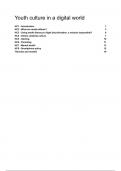Youth culture in a digital world
HC1 - Introduction 1
HC2 - What are media effects? 3
HC3 - Using media literacy to fight discrimination, a mission impossible? 6
HC4 - Online celebrity culture 7
HC5 - Gaming 10
HC6 - Parenting 11
HC7 - Mental health 13
HC8 - Smartphone policy 15
Theories and models 16
,HC1 - Introduction
Culture is a group’s distinctive way of life, including its beliefs and values, its customs, and
its art and technologies. This can be geographical, social and temporal.
- Youth culture has different main points:
● Has shared beliefs, behaviors, practices, and values of young people within a
particular society or subculture.
● Shows the ways in which young individuals express themselves, interact with one
another, and distinguish themselves from older generations.
● Is dynamic and can vary significantly across time and place, reflecting the cultural,
social, and historical context in which it emerges.
It can be seen in fashion and style, music, language, social activities, values and ideals and
media and technology.
Digital media: digital is binary and media is a way to spread information.
● It has disrupted/enriched traditional communication.
○ It’s not about face-to-face communication.
○ It’s a way to spread information.
There is a wide discussion whether digital media is a good thing or a bad thing. Several
theories focus on this and show whether digital media is disrupted or enriched:
● Social presence theory: ‘sense of being together’ is lower in digital media.
● Social information processing theory: communicators’ interpersonal needs prompts
them to try their best.
○ People have personal needs and are motivated to fulfill these needs.
■ To fulfill these needs they start to use digital media, this could work if
other things don’t resolve the problem.
○ Social media is not just disrupting or enriching our lives, it depends on the
receiver and how they process information.
● Channel expansion theory: users with experience will strive to develop necessary
skills. This happens with each new development in the digital world and enrichens
communication.
Digital media can be used as a replacement (of traditional media) or as an addition.
● People choose it because it comes from the idea that it’s the most efficient way to
communicate.
- It can be used in a passive or active way.
The uses and gratification theory explains why we use digital media and what functions
media gives us as active receivers. There are 4 forms:
1. Surveillance of the environment: people want to know what is going on in the
environment, so they can have control.
2. Affective need: people seek media content that evokes specific emotions.
3. Transmission of social heritage: we turn to the media to learn something (what is
socially acceptable and what not), so social norms can be set.
4. Entertainment: people look to fun things to help them feel good again.
The forms helpt to distinguish between different media platforms for reasons why it’s used:
● E.g.: Information - twitter, social - instagram, snapchat, entertainment - instagram,
youtube, convenience/pass time - all of them
The central question: What purposes or functions does media offer for active receivers?
1
, There are two approaches when looking at adolescents:
● Developmental tasks approach: developmental tasks/challenges need to be fulfilled.
○ The basic idea is that it’s a hierarchic list of tasks, met through biological or
social development. This is cumulative.
■ If you skip a stage you get problems later on.
○ Erikson’s developmental theory (→) and Havighurst
developmental theory are using this approach.
○ It states that (media)effects depend on age.
■ Scary media content can create trauma in
different ages. How they react is dependent on the age state:
● Perceptual stage (2-7 years): looking scary? → it is scary
● Conceptual stage (7+): not only perceptual and visual, but
more abstract and about being real.
● (<12 years): parents are role models.
● (+ 12 years): influencers are role models.
● Risk and resilience approach: children’s differential life experiences.
○ The basic idea is that risk and protective factors explain
differences between children (cumulative risk model).
○ It’s used for the snowball effect and turn around models.
■ Bronnfenbrenners’ ecological model has 3 stages:
● Micro: How do parents monitor and regulate
their children’s media use?
● Exo: Is school offering classes on online safety and social
media policies (e.g. banning phones from the classroom)?
● Macro: What do we believe and value regarding social media?
Is it entertainment, or dangerous?
Identity, physical and social aspects are interconnected, but not identical:
● Anonymity: different, more extreme form of behaviors (e.g cyberbullying). There are
no consequences of someone’s actions and harm of the cause. It isn’t directly visible.
● Creativity: playing around, discovering who you are. Someone can use filters to
represent yourself.
● Asynchrony: communication at your convenience, breaking time and space
constraints.
● Controbolity: the ability to decide what information to share or omit.
- The identity should be constructed during adolescence through online and offline
exploration (virtual/online identity vs actual identity).
● How different the online identity is from the actual identity is to a person itself.
● Two key components: self image (perceive themselve) and
self-esteem (ability to appreciate the self-image).
According to the Gofman self-presentation there are two ways for
self-representation:
● In the backstage someone can be themselves and relaxed in
an informal setting.
● In the frontstage, there’s dramatic interaction where there is
limited communication and information to share.
2




